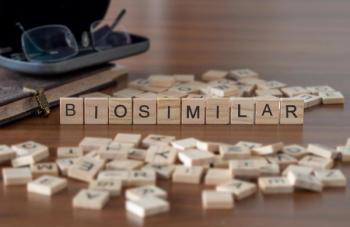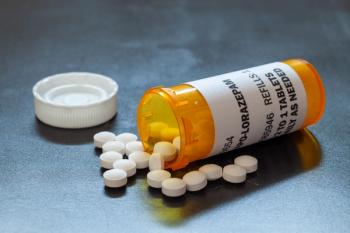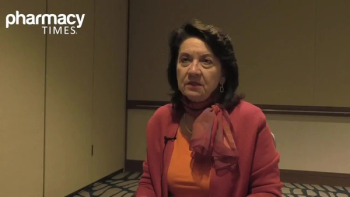
New Drugs Introduced in 2017: Part 5 Osteoporosis, Neurology, and Pain Management
This year, the FDA is on pace to approve about 38 new medications. Here is a look at 6 of these.
This year, the FDA is on pace to approve about 38 new medications. Additions to the drug market this year cover a variety of diseases and ailments providing prescribers with more options and the ability to optimize drug therapy. Part 5 is the last in this series and covers new medications for
Osteoporosis
Tymlos (abaloparatide)
The FDA approved abaloparatide on April 28, 2017, for osteoporosis. It is specifically indicated for the treatment of postmenopausal women with osteoporosis who are at a high risk for fracture (defined as history of osteoporotic fracture, multiple fracture risk factors, or patients who have failed other available osteoporosis therapy).1 Abaloparatide is a human parathyroid hormone related peptide [PTHrP(1-34)] analog. It acts as an agonist at the PTH1 receptor, which results in stimulation of osteoblast function and increased bone mass, via activation of the cAMP signaling pathway in target cells.1,2 Abaloparatide is supplied as a subcutaneous autoinjector pen (3120 mcg/1.56 mL) and is recommended to be dosed at 80 mcg (0.04mL) SQ once daily. It is not recommended to use this product for more than 2 consecutive years during the patient’s lifetime due to increased risk of developing osteosarcoma. Patients are also recommended to receive supplemental calcium and vitamin D while taking this medication if normal calcium levels are insufficiently maintained by dietary intake (typically < 9.0 mg/dl).2,3 The most common adverse effects of abaloparatide (>2%) include hypercalciuria, dizziness, nausea, headache, palpitations, fatigue, upper abdominal pain, and vertigo.2 Other warnings/precautions include orthostatic hypotension, hypercalcemia, and a black box Warning for osteosarcoma.2 The abaloparatide autoinjector pen costs about $2000, and it lasts about 30 days.3
Neurology
Xadago (safinamide)
Safinamide is a monoamine oxidase type B (MAO-B) inhibitor approved as adjunctive treatment to levodopa/carbidopa in patients with Parkinson’s disease experiencing off periods.4 Off periods refer to end-of-dose wearing off prior to the next scheduled dose of a medication. This happens in those with Parkinson’s being treated with levodopa/carbidopa due to the increasing loss of the ability to store dopamine, as well as the short half-life of l-dopa. These off periods result in the return of tremors, rigidity, and/or slowness.5 Safinamide exhibits its effects by inhibiting MAO-B, which is responsible for degrading dopamine. Clinical trials of safinamide showed that it reduces off periods by about 0.5 hours at week 24 relative to placebo. By comparison, other MAO-B inhibitors, such as rasagiline, reduced off time by about 1 hour.6 Unlike other MAO-B inhibitors, there are fewer dietary tyramine restrictions recommended for safinamide.4 Safinamide is dosed 50 mg once daily, and after 2 weeks the dose is increased to 100 mg once daily. To discontinue therapy, reduce the dose to 50 mg for 1 week before discontinuation. Patients with moderate hepatic impairment require the lowest dose of safinamide, and patients with severe hepatic impairment should not take safinamide.4
Common adverse effects include dyskinesia, hypertension, falling, and nausea. Safinamide, like all MAO-B inhibitors, has an extensive drug interaction profile, mostly centering around the possibility of serotonin syndrome. However, the safinamide package insert claim that it can be used with selective serotonin reuptake inhibitors (SSRIs), at the SSRI’s lowest effective dose.4
Austedo (deutetrabenazine)
The FDA approved deutetrabenazine on April 3, 2017, and it is the first and only approved medication for the treatment of both tardive dyskinesia in adults and chorea associated with Huntington’s disease. Chorea is a condition characterized by uncontrolled, involuntary movements (similar to tardive dyskinesias) and is one of many symptoms that occur in patients with Huntington’s disease.7 Deutetrabenazine’s major metabolites (alpha-dihydrotetrabenazine [HTBZ] and beta-HTBZ) act as vesicular monoamine transporter-2 (VMAT2) inhibitors, which decrease the uptake of monoamines, such as dopamine, serotonin, norepinephrine, and histamine, into synaptic vesicles, depleting the monoamine stores. However, the exact mechanism that this medication uses for its anti-chorea and tardive dyskinesia effects is unknown.7,8 Deutetrabenazine comes in 6 mg, 9 mg, and 12 mg tablets. Standard dosing for both indications is initially 6 mg once daily. This dose may increase weekly, based on response and tolerability in increments of 6 mg/day. If the total daily dose reaches > 12 mg, administer in 2 divided doses spread out throughout the day. The maximum recommended dose is 48 mg/day. Additionally, for those with tardive dyskinesia who are already being treated with tetrabenazine, starting/conversion doses are recommended according to the current dose of tetrabenazine: tetrabenazine 12.5 mg/day = deutetrabenazine 6 mg once daily, tetrabenazine 25 mg/day = deutetrabenazine 6 mg twice daily, tetrabenazine 37.5 mg/day = deutetrabenazine 9 mg twice daily, tetrabenazine 50 mg/day = deutetrabenazine 12 mg twice daily, tetrabenazine 62.5 mg/day = deutetrabenazine 15 mg twice daily, tetrabenazine 75 mg/day = deutetrabenazine 18 mg twice daily, tetrabenazine 87.5 mg/day = deutetrabenazine 21 mg twice daily, tetrabenazine 100 mg/day = deutetrabenazine 24 mg twice daily.8 The most common adverse effects of deutetrabenazine (>8% compared with placebo), include somnolence, diarrhea, dry mouth, and fatigue. Other warnings/precautions include neuroleptic malignant syndrome, akathisia/agitation, and depression/suicidal ideation, which applies to patients with Huntington's disease.8 This medication costs about $1900 for a 30-day supply of the 6 mg tablets.9
p.p1 {margin: 0.0px 0.0px 0.0px 0.0px; font: 11.0px Helvetica}span.s1 {font-kerning: none}
Ingrezza (valbenazine)
Valbenazine is a new medication approved by the FDA on April 11, 2017, for the treatment of tardive dyskinesia in adults. This medication differs from another similar, recently approved medication, deutetrabenazine, in that the label does not contain a black box warning for depression/suicidal ideation and is not specifically approved for the treatment of chorea associated with Huntington’s disease.10 Like deutetrabenazine, valbenazine’s exact mechanism for how it treats tardive dyskinesia is unknown. However, it is thought to be mediated through reversible VMAT-2 inhibition. This results in a decrease in the uptake of monoamines into the vesicles.10,11 Valbenazine is available as a 40vmg capsule. Standard dosing of valbenazine for tardive dyskinesia is initially 40 mg once daily. After 1 week, the dose should be increased to 80 mg once daily. However, continuation of 40 mg/day may be considered for some patients based on how they respond/tolerate the medication.11,12 The most common adverse effects of valbenazine (>5% overall and twice the rate when compared to placebo) include somnolence. The other main warning/precaution is QT interval prolongation.11,12 Valbenazine costs about $5300 to $6300 for a 30-day supply of the 40mg capsules.12
Radicava (edaravone)
The FDA approved Edaravone on May 5, 2017, and it is the first drug to be labeled for the treatment of amyotrophic lateral sclerosis (ALS) in more than 20 years.13 Edaravone is labeled a free radical scavenger, but its exact mechanism of therapeutic effect in patients with ALS is unknown.14 ALS or Lou Gehrig’s disease is a complex, progressive, and fatal neurodegenerative disease. ALS is incurable, and most patients survive only 3 to 5 years after diagnosis, so most forms of care are supportive in nature.15 Edaravone is an intravenous medication that is administered over an hour as 2 30 mg bags at 30 minutes per bag. Patients must be monitored for hypersensitivity reactions immediately following each dose. The initial cycle of edaravone requires once daily administration for 14 days, followed by a 14 day drug-free period. Subsequent cycles are given daily for 10 days, followed by a 14-day drug free period.14 Edaravone joins riluzole as the only other drugs indicated for the treatment of ALS. Compared with riluzole, edaravone has a cleaner safety profile, as it is not known to cause hepatotoxicity or neutropenia. Abnormal gait, bruising, and headaches are the most common adverse effects. The only contraindication for edaravone is hypersensitivity reactions.14
Pain Management
RoxyBond (oxycodone)
The FDA approved RoxyBond, a new formulation of immediate release oxycodone, on April 26, 2017. This oxycodone formulation is the first immediate-release opioid analgesic approved with labeling describing its abuse-deterrent properties. It is formulated with inactive ingredients that make the tablet more difficult to manipulate for misuse and abuse, even if physically manipulated. Specifically, it has increased resistance to cutting, crushing, and grinding. It also forms a viscous material that resists passage through a needle when mixed with various solvents. This makes intravenous injection extremely difficult.16 RoxyBond is supplied as 5 mg, 15 mg, and 30 mg tablets. It is recommended to begin dosing at a range of 5 to 15 mg every 4 to 6 hours, as needed for pain. The lowest effective dosage for the shortest duration that effectively controls the patient’s pain should be used. Individual dosing and titrations dependent on the patient’s severity of pain may be necessary.17 The most common adverse effects (> 3%) include nausea, constipation, vomiting, headache, pruritic, insomnia, dizziness, asthenia, and somnolence. Oxycodone is contraindicated in patients with significant respiratory depression or obstructive respiratory disease, known or suspected gastrointestinal obstruction, or known hypersensitivity to oxycodone. Other warnings and precautions include adrenal insufficiency, severe hypotension, and risk of worsening condition for patients with increased intracranial pressure, brain tumors, head injury, or impaired consciousness.17
This article was written with Christopher Robinson and Charles Vawters, 2018 PharmD Candidates at the Harrison School of Pharmacy at Auburn University.
References
1.
CenterWatch.
Tymlos (abaloparatide).
Accessed October 16, 2017.
2.
Tymlos [prescribing information]. Waltham, MA: Radius Health, Inc. 2017.
. Accessed October 16, 2017.
3.
Abaloparatide. In: Lexi-Comp Online, Lexi-Drugs [internet]. Hudson, OH: Wolters Kluwer Health/Lexi-Comp, Inc. c2017 [cited October 2, 2017].
4.
Xadago [prescribing information]. Louisville. KY: US WorldMeds, LLC. 2017.
accessdata.fda.gov/drugsatfda_docs/label/2017/207145lbl.pdf. Accessed October 16, 2017.
5.
FDA approves drug to treat Parkinson’s disease [news release]: March 21, 2017.
. Accessed October 16, 2017.
6.
Chen JJ, Swope DM. Parkinson’s disease. In: DiPiro JT, Talbert RL, Yee GC, et al, eds. Pharmacotherapy: A Pathophysiologic Approach. 9th ed. New York, NY: McGraw-Hill. 2014.
Chapter 43.
7.
CenterWatch.
Austedo (deutetrabenazine).
. Accessed October 16, 2017.
8.
Austedo [prescribing information]. North Wales, PA: Teva Pharmaceuticals USA, Inc. 2017.
accessdata.fda.gov/drugsatfda_docs/label/2017/208082s000lbl.pdf. Accessed October 16, 2017.
9.
Deutetrabenazine. In: Lexi-Comp Online, Lexi-Drugs [internet]. Hudson, OH: Wolters Kluwer Health/Lexi-Comp, Inc. c2017 [cited October 2, 2017].
10.
CenterWatch.
Ingrezza.
. Accessed October 16, 2017.
11.
Ingrezza [prescribing information]. San Diego, CA: Neurocrine Biosciences, Inc. 2017.
Accessed October 16, 2017.
12.
Valbenazine. In: Lexi-Comp Online, Lexi-Drugs [internet]. Hudson, OH: Wolters Kluwer Health/Lexi-Comp, Inc. c2017 [cited October 2, 2017].
13.
FDA approves drug to treat ALS [news release]. May 5, 2017.
14.
Radicava [prescribing information]. Jersey City, NJ: Mitsubishi Tanabe Pharma, Corp. 2017.
radicava.com/assets/dist/pdfs/radicava-prescibing-information.pdf. Accessed October 16, 2017.
15.
Morris S. ALS treatment. ALS News Today.
16.
Inspirion delivery sciences receives FDA approval for RoxyBond (oxycodone hydrochloride) tablets CII, the first and only immediate release opioid analgesic with abuse-deterrent label claims [news release]. April 26, 2017.
17.
RoxyBond [prescribiing information]. Valley Cottage, NY: Cerovene for Inspirion Delivery Sciences, LLC. 2017.
Accessed October 16, 2017.
Newsletter
Stay informed on drug updates, treatment guidelines, and pharmacy practice trends—subscribe to Pharmacy Times for weekly clinical insights.

















































































































































































































